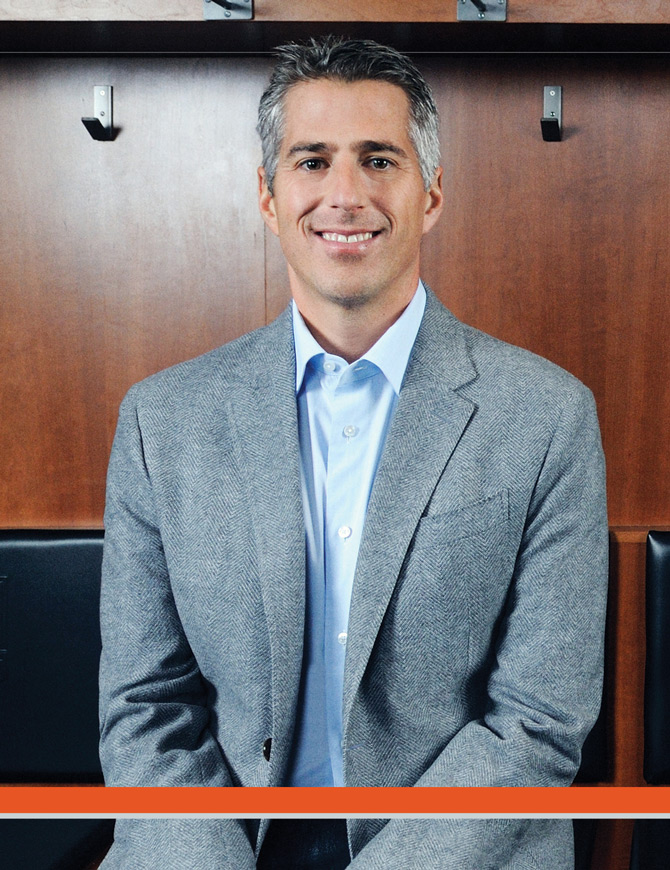The L.A. sports scene seems to have turned a corner. To what do you attribute that?
The ownership dynamic here has changed dramatically. You’ve had all of our teams turn over essentially since the late ’90s: Dodgers, Kings, Clippers. Two NFL teams left and [two] came back. And what all these owners have realized is that sports is a big business, and those businesses compete with all sorts of businesses that aren’t sports-related. [That requires] capital expenditures and support [to] make those best-in-class opportunities – and that’s what we have seen here.
Was there a catalyst?
Staples Center. Phil Anschutz and AEG really started the trend and it continued from there. L.A. always lacked world-class facilities. We had two NBA teams, one played in the Forum, which in its heyday was great but by the times the Lakers left was not great. And the Clippers played in the Sports Arena. The two NFL teams played at the Coliseum and the old Anaheim Stadium. Dodger Stadium is now the oldest in Major League Baseball behind only Fenway and Wrigley. We had not had the level of facilities that other cities around the country had.
But we had good enough infrastructure to accommodate the Olympics in ’84.
The real secret of the success of the Olympics in L.A. is not our facilities – its USC and UCLA. No city in the world has two universities of that level of reputation and quality with that scale of student population, with that caliber of athletic programs in the city center within 10 miles of each other. No city in the world has that. They have to recruit and attract students from all over the world, competing with the best universities all over the world, which means that the facilities of all sorts have to be at a standard that’s unique. And that was the heart of ’84, and will be the heart of ’28.
And this new generation of private facilities will benefit from the ’28 Games?
Think about it – only 35 cities in the world have hosted [Olympic Games]. Stan [Kroenke] will own a building that by the time we get to ’28 will be the only building in the world to have hosted two NFL teams, hosted a Super Bowl for sure, likely host a Final Four, likely host a World Cup final, and for sure host an Olympic opening ceremony. That makes it the most unique big building in the world. Staples Center is already the most successful stadium in terms of number of days, and now will host an Olympics. They’ll keep their facilities at the highest level possible because they know they will have the biggest and most important event in the world coming to their venues.
From an attendance standpoint, what’s your take on the knock that L.A. just has too much else to do to allow teams to draw fans consistently?
I just don’t think that’s true. You’ve got 18 million people in the region – so, yes, there’s lots going on, but you’ve got more people to pick from to fill a stadium. Look, Stan’s going to have 70,000 seats. If you assume that there are roughly three to four tickets per account, he needs roughly 20,000 to 25,000 season ticket holders out of 18 million people – it’s not that complicated. If you can’t do that, you’re doing something wrong. And let’s be clear: in the world we live in, the size of your city doesn’t correlate
to the amount of distractions there are. Most of the distraction sits in [a cell phone in] the palm of your hand. That’s universal.
What’s your favorite L.A. sports moment?
I was at the Stadium for Kirk Gibson in ’88. I was 14. That is one of the most iconic moments in the history of sports, and it happens to be in L.A. There were two other moments –
there were the Olympic games in general in ’84. Carl Lewis, Mary Lou Retton. Rafer Johnson, I mean, pick your moment. And the Lakers and Showtime. There was nothing more infectious than Magic Johnson and Showtime and the Celtics – those finals, that match-up – the energy that was the Lakers was incredible. But if I had to pick a single moment it was probably Kirk Gibson, and probably anyone in my age group would pick that moment.

